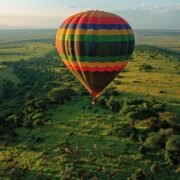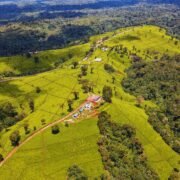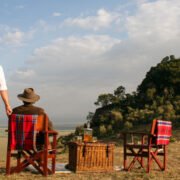
Why Kenya is the Ultimate Safari Destination
The Heartbeat of African Safaris
When people around the world dream of going on safari, it’s often Kenya that they picture. Endless golden plains, towering acacia trees silhouetted against orange sunsets, herds of elephants roaming beneath Mount Kilimanjaro, and lions lounging in the tall grass—Kenya is the spiritual home of safari.
Boasting over 50 national parks and reserves, Kenya offers the perfect blend of wildlife, scenery, culture, and adventure. From luxury tented camps in the Masai Mara to remote conservancies in Laikipia and the flamingo-filled shores of Lake Nakuru, Kenya’s safari experiences are as diverse as they are unforgettable.
In this guide, we’ll explore why Kenya stands as the ultimate safari destination—and why every wildlife lover, adventurer, or luxury traveler should make it their next stop.
1. The Big Five and So Much More
Kenya is home to the legendary Big Five: lion, leopard, elephant, buffalo, and rhino. But what truly sets Kenya apart is the sheer abundance and accessibility of its wildlife.
- Masai Mara offers the most consistent big cat sightings on the continent.
- Tsavo and Amboseli are famous for massive elephant herds.
- Lake Nakuru and Ol Pejeta provide some of the best rhino tracking experiences in Africa.
Beyond the Big Five, you’ll encounter giraffes, zebras, wildebeests, hippos, crocodiles, cheetahs, hyenas, jackals, and over 1,000 species of birds.
👉 Explore our Big Five Safari Itineraries
2. Home to the Great Wildebeest Migration
The Great Migration is one of nature’s most dramatic spectacles, and the Masai Mara offers a front-row seat.
From July to October, over 1.5 million wildebeests, zebras, and gazelles thunder across the Mara River in search of fresh grazing, facing crocodiles and predators at every turn. It’s raw, thrilling, and humbling—a bucket-list moment.
👉 Plan a Migration Safari in Kenya
3. Award-Winning Conservancies and Sustainability
Kenya pioneered the concept of community conservancies—private and community-managed lands bordering national parks that protect wildlife while empowering local communities.
Notable conservancies include:
- Ol Pejeta Conservancy – home to the last two northern white rhinos
- Lewa Conservancy – world-class rhino protection and luxury lodges
- Naboisho Conservancy – fewer vehicles, more wildlife, and intimate experiences
These conservancies offer night drives, bush walks, and off-road safaris—experiences not always permitted in national parks.
👉 See Our Private Conservancy Safari Options
4. Lodges That Redefine Safari Luxury
Kenya’s safari accommodations are as stunning as the wildlife. Whether you’re traveling on a budget or seeking ultra-luxury, you’ll find:
- Tented camps with plunge pools overlooking savannahs
- Open-air showers with giraffes nearby
- Eco-lodges powered by solar and built sustainably
- Family lodges, honeymoon suites, and mobile tent safaris
Top luxury stays include:
- Angama Mara (Masai Mara)
- Ol Donyo Lodge (Chyulu Hills)
- Loisaba Tented Camp (Laikipia)
- Saruni Samburu (Samburu)
👉 Browse Kenya’s Top Safari Lodges
5. Diversity of Landscapes
Kenya is not just savannah. Its geographic diversity means every safari circuit offers something new:
- Masai Mara: rolling grasslands and iconic big game
- Amboseli: elephants beneath Kilimanjaro
- Laikipia: highland plateaus and private ranches
- Samburu: semi-arid wilderness with rare species
- Lake Nakuru: pink flamingos and white rhinos
- Mount Kenya: alpine forests and snow-capped peaks
- Tsavo: Kenya’s largest national park with red-dusted elephants
👉 Explore Our Regional Safari Packages
6. Unique Wildlife Experiences
Kenya is the only country where you can experience:
- Hot air balloon safaris over the Mara at sunrise
- Walking safaris with Maasai guides
- Camel safaris in Samburu
- Rhino tracking on foot in Solio and Ol Pejeta
- Horseback safaris in the Chyulu Hills and Laikipia
- Chimpanzee sanctuary visits at Sweetwaters
👉 Read: Unique Safari Experiences in Kenya
7. Rich Cultural Encounters
Kenya isn’t just about animals—it’s also about people. Safari in Kenya offers meaningful interaction with the Maasai, Samburu, and Turkana peoples.
- Visit a traditional Manyatta (village)
- Learn about beadwork, dancing, and cattle culture
- Take part in cultural tours led by locals
- Support community tourism and local artisans
These experiences add depth and humanity to your wildlife journey.
👉 Combine Culture & Wildlife Safaris
8. Perfect for First-Time & Repeat Travelers
Kenya’s safari infrastructure is robust and reliable:
- Well-trained guides
- 4×4 vehicles designed for photography
- Domestic flights between major parks
- Lodges with Wi-Fi and mobile connectivity
- Excellent road networks
Whether you’re a first-timer looking for a guided package or a seasoned adventurer designing a private itinerary, Kenya’s safari ecosystem is equipped for both.
9. Year-Round Safari Destination
Unlike southern Africa’s defined dry/wet seasons, Kenya is a year-round safari destination:
- January–March: Hot, dry, excellent for photography and predators
- June–October: Dry, migration season, best wildlife visibility
- November–December: Green season, baby animals, great birding
- April–May: Rainy season (low crowds, budget deals)
👉 See: Best Time to Visit Kenya
10. Gateway to East Africa
Kenya’s capital, Nairobi, is a major international hub, making safari travel easy and accessible. From here, travelers can combine:
- Kenya + Tanzania (Serengeti, Ngorongoro)
- Kenya + Uganda (gorilla trekking)
- Kenya + Zanzibar (beach and bush)
- Kenya + Rwanda (culture & primates)
Whether you want a standalone Kenya safari or a cross-border adventure, Kenya is the best starting point.
👉 View Multicountry Safari Ideas
Bonus: Photography Paradise
Kenya is arguably the most photogenic safari destination in the world. From golden hour game drives to dramatic predator-prey scenes, Kenya is a paradise for wildlife photographers and Instagram travelers alike.






